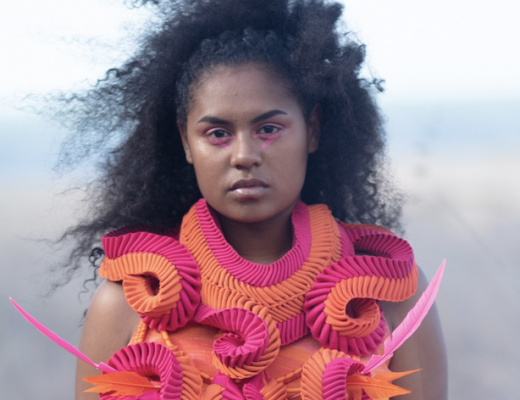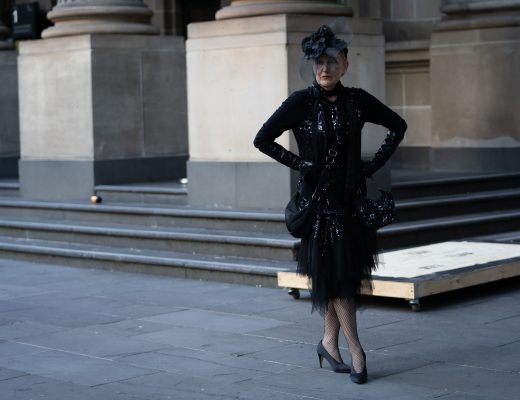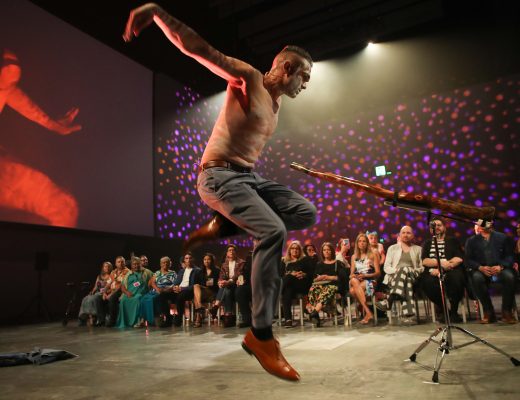Before Anna Wintour commissioned the seminal “Savage Beauty” in 2011, fashion exhibitions were considered the preserve of frock toffs and aficionados. Now look. Fashion is universally celebrated for its art, craft and the powerful, expressive language of human identities. Here Janice Breen Burns tracks the timeline back to Anna and forward to the NGV’s unique tribute (open until April 16) to a genius who changed us all.
(This story was first published in Creative Victoria FashioNews, your regular drop of local fashion yarns, best events, grants news, business info and lots more. Subscribe here for free.)

Less than a year after Alexander “Lee” McQueen’s suicide aged 39 in 2010, an exhibition of his life’s work opened in New York’s Metropolitan Museum of Art (MET). Savage Beauty triggered blocks-long queues, smashed attendance records and sparked a planet-wide re-think about fashion that’s had a knock-on effect in galleries ever since.

McQueen made shockingly beautiful (sometimes just shockingly shocking) fashion but, even more compelling, the ideas he plumbed from his own Scottish history, art and the state of humanity were easy for even the most average Average Joe to compute. No fashion connoisseurship required. Fascination guaranteed.
Many of the million-odd people who waited up to four hours to see Savage Beauty in New York and, four years later for its iteration at London’s Victoria & Albert Museum in 2015, had never been inside an art gallery before, let alone a fashion exhibition. McQueen was that compelling.

Savage Beauty shifted a widespread public perception at the time that fashion exhibitions were either trivial tizz or stuff best left to connoisseurs. Around the planet, they’re now considered relatable spectacles of art, craft and universal ideas.

It’s highly likely the National Gallery of Victoria’s Alexander McQueen: Mind, Mythos, Muse, on now until April 16, will be another record-breaking blockbuster (to add to the its list of record-breaking blockbusters in recent years including Jean Paul Gaultier, Viktor&Rolf, Dior and Chanel) because of it.
It’s been curated with Los Angeles County Museum of Art (LACMA), a gallery of similar size and culture to the NGV that recently ran its own blockbuster McQueen exhibition. And it’s installed with 80 artworks – some of the NGV’s, some from LACMA – interspersed with McQueen’s designs (also, some from the NGV’s permanent collection, some from LACMA’s) to tease out some of the concepts he plugged into to create them.

“When you spend time in the presence of his work you realise what an extraordinary storyteller he was,” says NGV Fashion and Textiles curator Katie Somerville. She’s spent two years immersed in McQueen’s work, nutting out the exhibition’s logistics with her LACMA collaborators. “He used the clothes to communicate ideas, either big grand existential questions, or more personal moving poetic ones…”
The exhibition itself is labyrinthine, its multi-sensory transitions, from soft-lit to radiant rooms, accentuated by alluring little corridors, evocative lighting, back-beats and video walls of runways and McQueen at work.

“It’s a very immersive experience,” says Katie, “A really rare and wonderful opportunity to understand the phenomenal maker he was and the incredible flights of fancy and imagination that sat behind his remarkable ideas…”
She says McQueen’s modus operandi should be even easier to grasp by the exhibition’s division into four principle themes. Mythos, Fashion Narratives and Evolution and Existence plug into passions that rocket-fuelled his work on collections such as the infamous tartened Widows of Culloden (autumn-winter 2006-07) and the clod-footed aquatic women of the future in Plato’s Atlantis (spring-summer 2010).
The fourth theme, Technique and Innovation, is where visitors should lean in, peer close, or risk missing the rare craftsmanship behind McQueen’s genius, according to Katie.

“As a technician, as a craftsperson, he was incredibly old school,” she says. “He was a (tailoring) apprentice on Savile Row so he knew that deeply considered history of his craft, he understood the fine, slow art of building and sculpting a garment…”
McQueen’s background gives no clue to the genius, the ability to plug like a socket into ideas, and the perfectionism that blossomed in his career and characterised his craft.
He was born in 1969 to a London cabbie, left school at 15 to apprentice on Savile Row, was selected for study at London’s prestigious Central St. Martins, was quickly spotted as a wunderkind and embraced by flamboyant fashion patron Isabella Blow before his low-slung tailored “bumsters” of 1994 and his Highland Rape collection of 1995 triggered enough controversy to widen his celebrity and mark him out as “one to watch”.

McQueen spent several years as creative director of Givenchy before returning full time to his eponymous studio and unleashing some of his best collections. “Each with a strong, multilayered narrative,” says Katie. “And what’s really exciting about this exhibition, is how you can see those myriad sources of his ideas…”
You can almost see and hear how McQueen’s mind ticked…

Alexander McQueen: Mind, Mythos Muse is on now at the National Gallery of Victoria until April 16, 2023. Tickets $35.
Extended opening hours in January also provide visitors with more opportunities to view the exhibition as well as NGV International’s 2022 Architecture Commission: Temple of Boom, open from 10am till 6pm, Sunday – Thursday until 29 Jan. For more of what’s on offer this summer go here.





